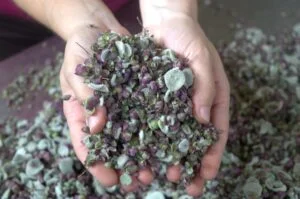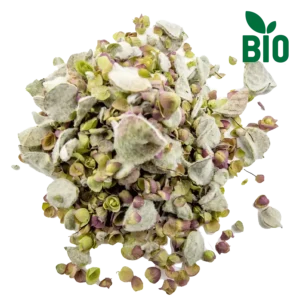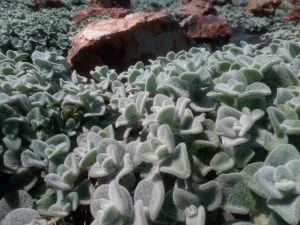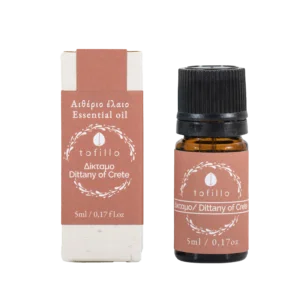People are looking for more wellness in their daily routine. Can a cup of dictum help you with your health, inspiration and well-being? The answer is yes, it can! Learn now about the properties and Cretan tradition that highlighted this herb.
This herb is special to Crete, and especially to us at tofillo – you can see that we use the image of its leaf in our logo!
Read on to explore with us what makes this herb so special…

Dittany is a perennial plant but when growing in the wild it appears only in very specific locations, usually at a specific altitude and on steep surfaces. Despite the difficulty of finding and collecting wild dittany, it has been over collected through the years and now has a very small wild growing population.
The wild collection of Dittany of Crete is therefore banned, and it now falls under the protection of specific provisions of both national Greek law and EU law. As a result, these days dittany is farmed by a select number of cultivators on Crete.
Dittany of Crete has an agreeable herbal scent with floral top notes and savoury undertones. Its flavour has mild notes of oregano and thyme, and it has a hint of spiciness and bitterness.
The plant is an embedded part of Cretan culture, and so the locals have given it various names over the years: diktamo is the most popular Greek name for the plant. The name diktamo is said to come from combining the name of the Cretan mountain, Dikti, and the word for shrub. Hence, ‘shrub of Dikti’. Other names used include titamo, erontas, frankincense grass, mouth grass and stagnant grass.
Cretan Dittany can be found in the natural environment of Crete usually in steep locations. The altitudes may vary, but typically you will find the plant at 500-700 meters above sea level. Naturally, because of its name, you can expect to find it in the rock crevices on the northeastern slopes of Mount Dikti!
The herb can withstand low temperatures but requires well-drained, slightly alkaline soil in a sunny location. Any moisture or poor drainage of the soil may cause disease and degrade the product quality.
Dittany can be harvested all year round, but for healing purposes you have to harvest the herb when it just starts to develop some colour, but before its purple flowers appear.
Immediately after harvesting the plant, you should dry it without delay. This can be done by placing it in a dark and well-ventilated area. Once the herb is dried out, you can then store it in a well-sealed container away from heat and sunlight.


Dittany is a perennial plant and when it grows in nature it appears in hard-to-reach locations, usually at a certain altitude and on steep mountain slopes.
There are so many incredible facts about Cretan Dittany!
Although it is a compact shrub, growing to a maximum of 30cm tall, the plant is easily noticed – it has white stems with thick, heart-shaped leaves and its bracts turn to be purple-red just before blooming. The leaves are attractive and often used ornamentally: they have an upper layer of silvery, fine hairs that give the plant a slightly shimmery appearance.
And these silver hairs aren’t just nice to look at! They’re also a useful indicator of how much water the plant has received over the summer season – the less fluff, the more water it has received. Typically, wild dittany will have more silver hairs than cultivated dittany.
Dittany’s plant begins to flourish in early summer: the green bracts (leaf structures within the plant) begin to change from green to a purple-red colour and it gradually begins to flower with light purple flowers.
Dittany can be consumed and is often used to flavour various beverages, including liquors and wines. In fact, it is one of the key ingredients of vermouth! Typically, the herb is infused in the liquor to extract the flavour. More broadly, and especially in Cretan culture, it is used to make a herbal tea or tonic for consumption.
Although Cretan Dittany’s main use is in drinks and herbal remedies, it can also be used in cooking. It has a mild oregano flavour, and so can sometimes be substituted for oregano.
We have briefly touched on the history and myth of Dittany of Crete – there is a lot to explore on this subject!
According to Greek mythology the herb was dedicated to Artemis, the goddess of hunting. It is said that Artemis healed the wounds of those struck with arrows with the dittany plant. In Cretan mythology, it was said that the Cretan goddess of childbirth, Eilithia, wore a dittany wreath on her head to signify her power to facilitate difficult births.
Dittany has also been used to symbolically represent love. The herb is considered an aphrodisiac and in local speech is sometimes referred to as “love”! This symbolism is related to its harvest. Because it often grows in steep and inaccessible places it is said that only those who are truly in love and willing to risk their lives to give the herb to a loved one can obtain it. Indeed, it was once collected by young men to give as a token of their love.
We have already noted the plant’s heart-shaped leaves, which is very apt when you consider the symbolism!
There is much more to learn about the myth and tradition of Cretan Dittany. Among its many cultural references is its use for healing in the Harry Potter books by JK Rowling. To learn about how dittany is used and represented in the magical world of Harry Potter, take a look at our article on this subject.
Historically, Dittany of Crete has long been noted for its medicinal and healing properties. Homer, as early as the 9th century BC, reported that the herb was used as a remedy for gastric ulcers and bleeding. The famous Ancient Greek physician Hippocrates prescribed the plant to cure a variety of ailments, including for complaints of the digestive system and as a poultice for healing wounds.
Subsequently, the famous Ancient Greek philosopher Aristotle wrote that, because of Cretan Dittany’s healing properties, when wild goats were hit by an arrow, they would go in search of the herb for it to help eject the arrows from their bodies.
The poet Virgil, of the later Ancient Roman period, also mentioned the herb in his famous epic poem The Aeneid. In this, the goddess Venus herself used the herb to heal her son Aeneas after he was injured in battle.
Indeed, the Ancient Greeks believed the plant to be a panacea – a cure-all. Evidence of its use from the Minoan era has been discovered at the Palace of Knossos on Crete, and the plant was often depicted on pottery and murals of the time. Even in later medieval times, the herb was used by Benedictine and Trappistine monks to flavour their liquours.
One final note – it’s important to remember that references to ‘burning bush’ are to a different species of the herb (Dictamnus albus), and not to Cretan Dittany (O. Dictamnus).
Discover the beneficial properties of Dittany and visit our online store to order our Organic Dittany of Crete.

Traditionally, people have used dittany for wound healing, digestive ailments, antibacterial properties, anti-hemorrhagic properties, antispasmodic properties and to relieve nausea. While further scientific studies need to be undertaken, we’re seeing some confirmation of these traditional uses in the scientific research.
A study in 2015 found that essential oil of Cretan Dittany exhibits significant antibacterial properties.[1] Additionally, because of Cretan Dittany’s content of carvacrol and flavonoids, it also exhibits antioxidant properties. This makes it a useful herb to combat various health issues caused by inflammation and free radicals.
Additionally, the European Medicines Agency has approved the use of the herb in herbals teas for the relief of coughs, mild disorders of the digestive system, in topical application to use for minor skin inflammation and bruises.[2] The agency recommends that the tea should not be used longer than one week for a cough, and two weeks for digestive issues, without seeking advice from a healthcare provider.
More research needs to be conducted on Cretan Dittany’s side effects. However, one important precaution must be noted – Cretan Dittany should not be consumed by women during pregnancy as the herb can often cause miscarriage.
Cretan Dittany is most popularly used as a herbal tea. Culturally, it is an important part of the Cretan diet and many of its therapeutic benefits can be obtained by drinking its tea.
At tofillo we love to prepare an infusion for tea in the following way:

To obtain the benefits of essential oil of Cretan Dittany, one can use aromatherapy techniques (such as oil burning and using in soaps) or apply to the skin topically. When applying to the skin make sure always to dilute the essential oil with a carrier oil.
To learn more about using essential oils, and their benefits, read our previous article on this subject.
We hope you enjoyed learning about some of the incredible benefits, myths and traditions of this unique herb! Truly, Dittany of Crete has captivated people through the centuries and continues to hold a special place in therapeutic and cultural traditions to this day.
If you’d like to include some Cretan Dittany into your daily diet, you can view our product page for our Organic Dittany Tea where you can learn more about the product and place an order.
We hope you enjoy it, and when you drink it that you feel some connection with the amazing and unique traditions of Crete!
[1] https://www.ncbi.nlm.nih.gov/pmc/articles/PMC4424236/
[2] https://www.ema.europa.eu/en/documents/herbal-summary/dittany-crete-herb-summary-public_en.pdf
Subscribe to our newsletter to stay informed about herbs, recipes, exclusive offers, and receive a 15% discount on your first order!

Ευχαριστούμε πολύ τα παρακάτω websites για τη συνδρομή τους σε επιπρόσθετο, ελεύθερο φωτογραφικό υλικό (free stock) που χρησιμοποιείται στην ιστοσελίδα μας:
Pixabay.com
Pexels.com
Unsplash.com
Freepik.com
Canva.com
Adobe.com
Σταύρος Δεβεράκης (Φωτογράφος)
Many thanks to the following websites for their subscription to additional, free stock photography used on our website:
Pixabay.com
Pexels.com
Unsplash.com
Freepik.com
Canva.com
Adobe.com
Stavros Deverakis (Photographer)